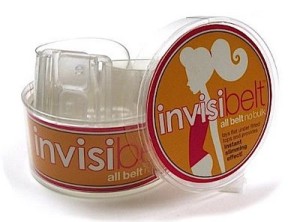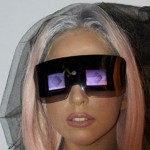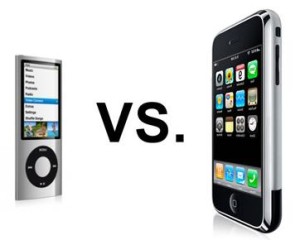Jobs: Past and Present
Ask someone who Steve Jobs is and they’ll say the founder of Apple, the guy who gave us the iPod, iPhone and iPad, among so many other things. Some, like myself, will go as far as saying the guy who taught us the importance of a strong, consistent brand.
Tomorrow with the opening of JOBS, the official Steve Jobs movie, the world will get a look into the life of the great Steve Jobs.
To celebrate, let’s take a step back in time and enjoy a clip from the 2001 WWDC where Steve Jobs first unveiled the truly revolutionary iPod.

Still need a little more Steve Jobs? Check out the official trailer for JOBS. If you’re not already excited for this movie, I think this trailer will do the trick. Enjoy!

Product Naming: Invisibelt

Love this product. Love the name just about as much. While it's reminiscent of my school-girl dreams of becoming Wonder Woman one day (yes, it was a gold belt but an invisible plane), this product meets the needs of women on so many levels. No longer having to choose a traditionally bulky accessory, gals can keep their fashion integrity while still maintaining comfort and style.
The manufacturers of the Invisibelt could have gone a lot of different directions when deciding on a name - trendy, obscure, arbitrary. Instead, they spoke to form and function. Nice job being clever with a descriptive name.
When does a Newly-Merged Portfolio become a “Dysfunctional Family?”
There is always excitement and discomfort with change. Your portfolio of products or services may change gradually through organic growth or expand suddenly due to a merger or acquisition. There is a prayer you can manage portfolio change with care in the former case, but sudden growth always raises key challenges.
When Portfolios Merge
There is usually a sound business strategy behind a corporate merger. This could include expanding an identical product or service into an enlarged geographic footprint or expanding an array of products within the same general product category. The closer the add-on products are to the original, the easier it will be for company employees and customers (new and merged) to embrace the new products.
However, let’s consider the corporate combination (whether small or large scale) that introduces whole new categories of merchandise or service to the buying audiences of both former entities. Now HERE’s where internal AND external brand positioning mind-bending can occur.
Questions can start to creep in that could well affect the overall corporate brand, its place in the cosmos, its reason for being. This may sound overly dramatic, but altering a portfolio mix will have a direct functional impact on every level of the organization. Some might be minor, like adding a few pages to a catalogue or web site, or redrafting the organizational chart. But, unless strategic clarity is applied to the change, the rationale and subsequent merger execution could also never quite congeal with employees and customers.
Who Needs to Know What
WHY did this merger happen, to whom does it make the most sense, who benefits and how? A logical explanation must be given to all employee groups. And not just once, but as an ongoing reminder to sustain the pain of adjustment they will be enduring. You can simply call it vigilant internal communications, but, for it to be truly successful, it should really be a long term, internal MARKETING campaign. Nothing less than the integrity of the overall, master brand is at stake.
Certainly, external audiences, especially all current and potential customer groups, should receive clear and consistent messages about why these new products are now part of the corporation’s offering. It should be seen as a rationally expanding family group, with next to none of the externally visible dysfunction any newly-blended family inevitably experiences.
Going Forward
THEN, how you avoid purchase decision-making confusion or paralysis from that point on has a lot to do with how the portfolio is structured and how products are named. Pay close attention to what everything is called. If names need to change, allow adequate time for all involved to absorb and become familiar with the change. Blending companies is just as delicate a task as merging families… just a heck of a lot larger!
Contributed by Bev Brandt
Sibling rivalry: iPods vs. iPhones
My mother is obsessed with her iPhone. While she taps away on her touchscreen all day, she asks me why I don’t trade in my "clearly less superior" iPod nano (5th generation) for Apple's newer flagship device. My typical response is that my iPod is my music device and nothing more, and that's the way I like it, thank you very much.
But then people started using Facebook from their iPhones. Then Angry Birds became popular to play on-the-go. Now, all of my friends have started playing Words with Friends (appropriately).
But me? I'm still here with my iPod. And I'm starting to think my mom has a point.
We are approaching an age of the all-or-nothing device. Phones aren't appealing to consumers unless they can offer Internet access, Skype capabilities, a slew of apps, e-mail, a GPS, video players, and music, just to name a few features. The basic iPod, which is only a music (and sometimes video) player, simply can't compete anymore, and so its brand is suffering a slow demise.
The iPhone, on the other hand, is so adept at meeting every technological need that Apple is willing to let the iPod brand be exceedingly eclipsed by the iPhone brand. Why would Apple invest time and money to revive an increasingly irrelevant iPod brand, when it can minimally advertise the lucrative iPhone and garner massive earnings?
By choosing to essentially leave its iPod brand strategy alone, Apple's sales are starting to reflect iPhone domination. Where iPod sales superseded those of iPhones by $13 million in 2010, that amount shrunk to only a $3 million difference in the first quarter of 2011. If the sales gap diminished that much in just one year, the outlook seems very favorable for iPhones.
The iPod brand's last saving grace could be its highly established brand image. Like it or not, iPhones will always have their roots from the iPod brand, both in name and in likeness – and many people will always refer collectively to the products as "iPod" devices. Even so, it will be difficult for iPods to hold their own in the coming years against their all-encompassing, digital successors.
Contributed by Allison Meeks
More than Just Java: Starbucks Follow-Up

From new sizes to a new logo, the Starbucks brand has seen many changes in the last year. Following the introduction of wine and beer to its menu options, Starbucks has also extended its food offerings.
Starbucks is introducing a line of " bistro boxes," in snack and entree sizes, priced from $4.95 to $6.95 and all under 500 calories. The initial entrees are chipotle chicken wraps, sesame noodles, chicken lettuce wraps and salumi and cheese. The new menu items reflect a ramped-up emphasis on food at Starbucks, which has generally focused on breakfast sandwiches and pastries.
From booze to bistro boxes, Starbucks has moved far beyond the classic cup of joe. The Starbucks brand started with a focus on coffee. Baristas were trained in coffee knowledge and served high quality coffee due the strict control over the quality and processing of the beans. Aroma, atmosphere, flavor and store design stimulated all five senses and contributed to an overall "Starbucks Experience."
Though food items are nothing new, previously served pastries acted as complements to the coffee. As the menu at Starbucks keeps growing, edible items are standing out on their own. I don't want to wash down my chipotle chicken with a vanilla latte. Add other innovations such as books and music to the mix and it's no surprise Starbucks dropped the word "coffee" from its name and logo.
New ideas and expanded menus don't appear to be a problem for Starbucks loyalists. With corporate restructuring plans in place and new stores opening in India and Vietnam, expansion of the Starbucks brand doesn't seem to be slowing any time soon.
Polaroid gone Gaga!
Looks like Polaroid has been re-branded by none other than Lady Gaga. The pop-culture icon has a new vision for Polaroid—literally. Since January 2010, the Fame Monster has taken on the role as creative director for Polaroid, designing and branding their latest round of camera products. There is still Polaroid brand equity for Gaga to reclaim and reinvent as the "camera" evolves.
The new line, Polaroid Grey Label, will maintain the brand’s core values of simplicity, authenticity, and sharing, while targeting a new generation with the futuristic style of Lady Gaga. The Grey Label is coined from “greige goods” a fashion term for fabric in its purest form. The name expresses the simplicity of Polaroid and the style of Gaga.
The most intriguing product presented is the Polaroid GL20 Camera Sunglasses. The product was inspired by the idea to fuse the icon of instant photography, with the queen of fashionable eyewear. These glasses not only allow eye protection from the sun, but also have a built-in camera that takes pictures and video. The camera fits on the bridge of the nose and the display screens are just below eye level, not to interfere with one’s line of vision. Not only can you take pictures with these glasses, you can also play them back to the world as you live it.

Another Grey Label item is the Polaroid GL10 Instant Digital Camera. Don’t be deceived by the boxy, old-fashioned look. This camera prints digital images right into your hands! It comes with a modern LCD screen display, and brings back instant image printing, defining the Polaroid picture of the new age.

The final product is called the GL10 Instant Mobile Printer. It’s a mini machine for printing photos instantly from your phone or camera anywhere-- at a party, in the office, in the car—and it’s small enough to put in a purse. It acts as a functional tool as well as a fashion accessory. According to Lady Gaga, "This product will revolutionize how we see photos. Your images will no longer die a death on your cell phone or digital camera."
The Instant Mobile Printer, Instant Digital Camera and the Camera Glasses are a unique “look” at how to turn images into a fashion statement. The products are coming out this summer 2011, and there’s no question they will require a large chunk of change. However the price of a Polaroid in it's heyday of the 90s did not detract from the allure of the brand. Hopefully the Grey Label will provide the same appeal.
Contributed by: Emily Hassell
FDA Approval: Edarbi
FDA approves Edarbi to treat high blood pressure (source: FDA Press Announcement)
On Friday, February 25, 2011, The U.S. Food and Drug Administration approved Edarbi tablets (azilsartan medoxomil) to treat high blood pressure (hypertension) in adults.
Data from clinical studies showed Edarbi to be more effective in lowering 24-hour blood pressure compared with two other FDA-approved hypertension drugs, Diovan (valsartan) and Benicar (olmesartan).
“High blood pressure is often called the 'silent killer' because it usually has no symptoms until it causes damage to the body,” said Norman Stockbridge, M.D., Ph.D., director of the Division of Cardiovascular and Renal Drug Products in the FDA’s Center for Drug Evaluation and Research. “High blood pressure remains inadequately controlled in many people diagnosed with the condition, so having a variety of treatment options is important.”
Edarbi will be available in 80 milligram and 40 mg doses, with the recommended dose set at 80 mg once daily. The 40 mg dose will be available for patients who are treated with high-dose diuretics taken to reduce salt in the body.
Blood pressure is the force of blood pushing against the walls of the arteries as the heart pumps. If blood pressure rises and stays high over time, it can damage the body in many ways. Nearly 1 in 3 adults in the United States has high blood pressure, which increases the risks of stroke, heart failure, heart attack, kidney failure, and death.
Edarbi is an angiotensin II receptor blocker (ARB) that lowers blood pressure by blocking the action of angiotensin II, a vasopressor hormone.
Adverse reactions reported by patients taking Edarbi in clinical trials were similar to those reported by those taking an inactive drug (placebo).
Edarbi has a boxed warning that says the use of the drug should be avoided in pregnant women because use of the drug during the second or third trimester can cause injury and even death in the developing fetus. If a woman becomes pregnant while using the drug, it should be discontinued as soon as possible.
Edarbi is made by Takeda Pharmaceutical North America of Deerfield, Ill.
For more information on pharmaceutical naming, branding, research or submission documents, please contact Vince Budd at Addison Whitney via email or phone 704.697.4021.
EMA Approval: Jonexa
Jonexa (hylastan) is a bacterially fermented product derived from hyaluronan that is indicated for the treatment of pain associated with OA of the knee and administered in one or two injections. Genzyme expects to launch Jonexa in select European Union markets and Hong Kong in 2010 because they believe opportunity exists in those markets for a lower cost, more convenient OA treatment option than locally available multiple injection products.
For more information about recent drug approvals or pharmaceutical branding, please contact Vince Budd at [email protected]
FDA Approval: Viibryd
Clinical Data, Inc. (NASDAQ: CLDA), today announced that the U.S. Food and Drug Administration (FDA) has approved vilazodone HCl tablets, to be marketed under the brand name Viibryd™, for the treatment of adults with major depressive disorder (MDD). Viibryd is a new molecular entity and the first and only selective serotonin reuptake inhibitor and 5HT1A receptor partial agonist. Clinical Data plans to make Viibryd available in U.S. pharmacies in the second quarter of this year.
“It is also the first drug that the Company has developed, and to have received marketing approval from the FDA on its first review is a significant milestone for Clinical Data.”
"When treating MDD, our goal is to offer treatment options that meet the individual needs of each patient," said Stephen M. Stahl, M.D., Ph.D., Professor of Psychiatry, University of California, San Diego. "Viibryd is an important new treatment option with proven efficacy and a demonstrated safety profile."
The mechanism of the antidepressant effect of Viibryd is not fully understood but is thought to be related to its enhancement of serotonergic activity in the central nervous system (CNS) through selective inhibition of serotonin reuptake. Viibryd is also a partial agonist at serotonergic 5HT1A receptors; however, the net result of this action on serotonergic transmission and its role in Viibryd's antidepressant effect are unknown.
For more information about recent drug approvals or pharmaceutical branding, please contact Vince Budd at [email protected]
Starbucks Goes Bigger
On the heels of the new logo debut last week, Starbucks announced a new drink size for its iced beverages on Sunday. "Trenta" will be a 31oz size specifically for iced coffee, iced tea and iced tea lemonade drinks in the United States (read: Venti is still the largest you coffee addicts can get for your java fix).
In case you need a refresher, here's the lineup of current Starbucks sizes:
Four sizes for hot beverages:
* Short (8oz)
* Tall (12oz)
* Grande (16oz)
* Venti (20oz)
Four sizes for cold beverages:
* Tall (12oz)
* Grande (16oz)
* Venti (24oz)
* Trenta (31 oz)
(Notice that the actual ounces are different between the Venti size in hot and cold beverages.)
So with discrepancies in size continuities across product lines, it's a lesson in creating a strong brand strategy from the onset.
Customers have long questioned Starbucks' naming strategy when it comes to their beverage sizes. It's a challenge to retrain a population so familiar with "Small, Medium and Large." Even I have to remind myself that it's a TALL, not a SMALL, when ordering, but it's also a very distinctive strategy that mimicked the brand experience they were evoking.
From a continuity perspective though, I'm not sure it makes the most sense.
Dictionary.com posed a nice question on this as well: if the names were created to relate to the actual product size, why not simply use the actual size? Studying the etymology of Starbucks size names, you'll find that Grande is Italian for "large," Venti is Italian for "twenty," and Trenta means "thirty." Tall lacks the panache of the other size names, but it's still a part of their nomenclature. Venti translates nicely for a 20oz hot beverage, but not exactly for the cold beverages at 24oz, unless it means "twenty-ish."
What do you think? Is Starbucks doing its customers a disservice by not having a more "mainstream" naming strategy? Or is that too, just a part of the brand experience?

